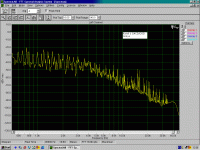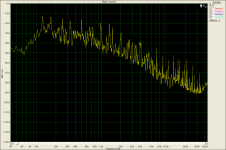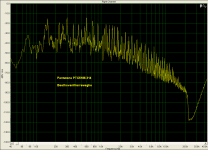But to move towards when we can carry out such survey properly, anyone have a list of DSD recordings which are both musical and have significant supersonic energy?
Telarc SACD-60616
Telarc SACD-60601
Long live Renner and especially Bishop.
There are more titles, mostly Telarc.
Attachments
Last edited:
On contrary to previous:
That one looks rather like it started life as redbook - the bandlimiting to 22k is evident.
That one looks rather like it started life as redbook - the bandlimiting to 22k is evident.
Sure. And you will find so many similar "DSD" recordings. TELARC was a real exception. I am not sure about situation now when Michael Bishop left and they probably are not that much involved in SACD.
Putting aside the OOB stuff for a moment, in my experience the list of recordings which are both DSD and musical is an empty one - with just a single exception...)
I prefer DXD to the castrated monobit DSD. But i'm in the minority and DSD is gaining popularity to keep cheating salami-filled audiophools ears.
I much prefer the TELARC sound before they went over to DSD. Won't touch any of their DSD ones - 'Desperately Squashed Dynamics'.
To me, their DSD recordings dated about 2003 - 2006 sound very natural. Most close to the sound I know from concert halls - to me. Anyway, I do not want to argue, taste may be different.
Thanks for this Pavel.Telarc SACD-60616
Telarc SACD-60601
Long live Renner and especially Bishop.
There are more titles, mostly Telarc.
If you analyse any more, please post.
How do you do the analysis? Do you play them on a computer with a DAW? Please excuse my naive questions.
What is the time sample analysed? [edit] Oops! I see it is 16K @ 96kHz ie 167ms. Any reason why you chose this 167ms period? [/edit]
Telstar, if you know of any DXDs with musical material and also significant supersonics please post the disc reference and any measurements you may do.I prefer DXD to the castrated monobit DSD. But i'm in the minority and DSD is gaining popularity to keep cheating salami-filled audiophools ears.
Last edited:
Richard, analog output of SACD players were digitized, mostly Marantz SA7001, but the 1st plot (Ravel) was Onkyo DV-SP503 universal player. USB sound cards behind analog output of players, sampling 96kHz/16bit and 96kHz/24bit (for these spectra it does not make much difference if 16bit or 24bit A/D). Some of the plots are quite old, like 6 years, and I do not have the exact setting (window length etc.) recorded.
Anyway, it is quite easy to sort recordings regarding spectral content above 22kHz.
Anyway, it is quite easy to sort recordings regarding spectral content above 22kHz.
So Scott, you prefer microphones with audio FLAWS instead? '-)
If you read the two part series in Linear Audio, you'll see the real contribution Scott has made to doing the electronics in condenser mikes correctly. I think Jan sent you copies, it's worth studying and learning- some of it is very subtle, but anyone who wants to understand how to do it right will immediately grasp some fundamental issues which are often glossed over in commercial designs.
Are-you asking why sound engineers do not use very often Bruel & Kjaer mikes ?What amazes me is the inconsistency of SUBJECTIVE opinions on mikes, compared to ACTUAL MEASUREMENTS
Sure. And you will find so many similar "DSD" recordings. TELARC was a real exception. I am not sure about situation now when Michael Bishop left and they probably are not that much involved in SACD.
Samples are free avail:
High Resolution Music DOWNLOAD services .:. FLAC in free TEST BENCH
Model: 4180 noise: 18 dB A While Neumans are 15 - 17 5dB A Not so different. The reason is they do not sound so good ;-)Noisy, I would guess. Especially small diaphragm types.
Surprised, but I can make the difference in the same tune between 96KHz and 192KHz even on my PC speakers !!!Samples are free avail:
High Resolution Music DOWNLOAD services .:. FLAC in free TEST BENCH
I have to organize a blind test, i do not believe-it !
Scott did a good job. No more than I have done over the years with microphones, however. I don't see any breakthroughs here.
As far as mike diameter is concerned, 1/2'' is OK as far as noise. At least George Quellet, Mark Levinson, the Grateful Dead, John Meyer, Crystal Clear, etc found B&K 1/2'' acceptable, ESPECIALLY when I got B&K to upgrade their input resistor in 1974. Since then, they have been about 6 dB better in portions of the spectrum.
The VERY IDEA, however, that SY recorded successfully with a 1/4" B&K, except for a specific test, is absurd, because they ARE too noisy. They have to be, because of the limitations in the capsule output and the very low capacitance of the capsule. A real headache!
Now where does this leave us? YES, these 1/2'' B&K mikes can be boring, many claim it to be, BUT that is its SIGNATURE, and I defy you to tell me exactly what makes it so.
Other mikes, many good ones, are preferred because they have ADDED characteristics that make them useful, like a bumped up mid hi end, directionality, PERSONALITY.
Many popular singers DEMAND that their favorite mike be used to record them, sometimes they own them and bring them to the recording session. So where is the 'objectivity' here?
As far as mike diameter is concerned, 1/2'' is OK as far as noise. At least George Quellet, Mark Levinson, the Grateful Dead, John Meyer, Crystal Clear, etc found B&K 1/2'' acceptable, ESPECIALLY when I got B&K to upgrade their input resistor in 1974. Since then, they have been about 6 dB better in portions of the spectrum.
The VERY IDEA, however, that SY recorded successfully with a 1/4" B&K, except for a specific test, is absurd, because they ARE too noisy. They have to be, because of the limitations in the capsule output and the very low capacitance of the capsule. A real headache!
Now where does this leave us? YES, these 1/2'' B&K mikes can be boring, many claim it to be, BUT that is its SIGNATURE, and I defy you to tell me exactly what makes it so.
Other mikes, many good ones, are preferred because they have ADDED characteristics that make them useful, like a bumped up mid hi end, directionality, PERSONALITY.
Many popular singers DEMAND that their favorite mike be used to record them, sometimes they own them and bring them to the recording session. So where is the 'objectivity' here?
What was the signal source - S-D DAC by any chance?
Source was SACD, and we had selected music with lots of high freq content.
jan
The VERY IDEA, however, that SY recorded successfully with a 1/4" B&K, except for a specific test, is absurd, because they ARE too noisy.
That's part of the problem and one reason why I stopped using them and (at the time) went back to modified C-37s. But the noise wasn't terrible considering the media available then (pre-digital, I used Ampex 351) and the noise level inherent in live venues (I didn't do much studio work). The main problem was the overall sound, which I couldn't get past; this is not music reproduction, it's music production. Perhaps a more skilled recordist could have made things sound livelier and warmer, but I couldn't, whereas using the Sonys (for all their flaws), I could get a pretty realistic capture of the events.
Your point about musicians wanting certain sounds is absolutely correct- music production is a very subjective thing.
Wow!! So the mike should not be neutral and distortionless 
So we get to the conclusion that technologically "perfect" sound recording and reproduction is far from true natural sound? And we know well that original soundfield cannot be recreated by mikes and speakers? Some like NP probably realized that decades ago

So we get to the conclusion that technologically "perfect" sound recording and reproduction is far from true natural sound? And we know well that original soundfield cannot be recreated by mikes and speakers? Some like NP probably realized that decades ago
- Status
- Not open for further replies.
- Home
- Member Areas
- The Lounge
- John Curl's Blowtorch preamplifier part II


